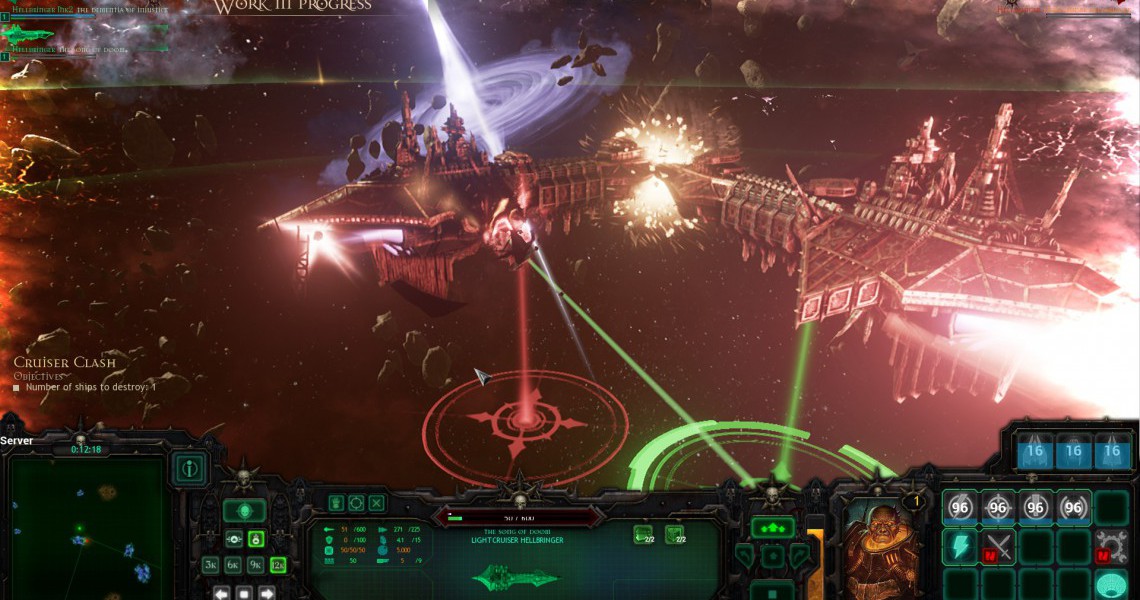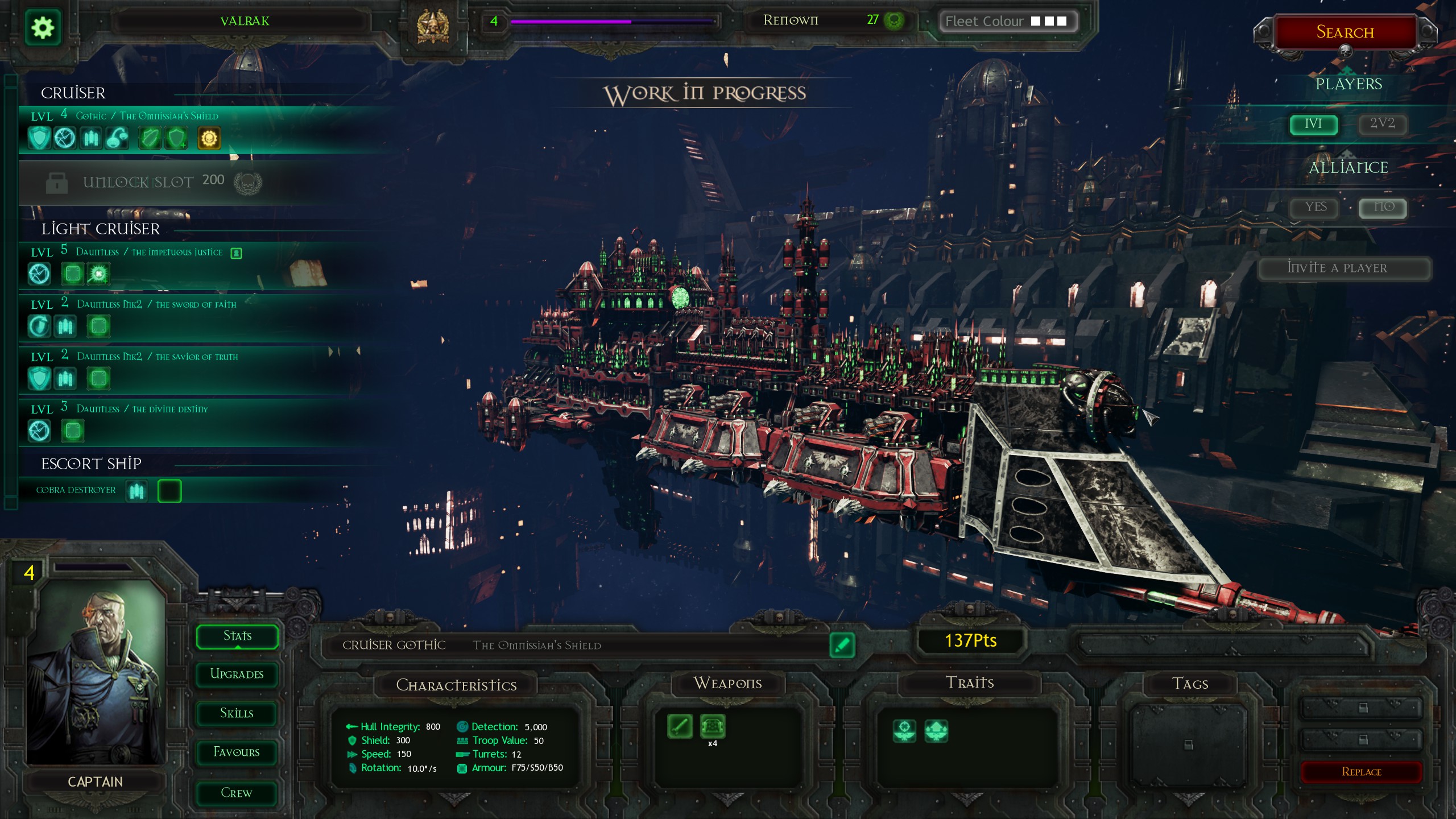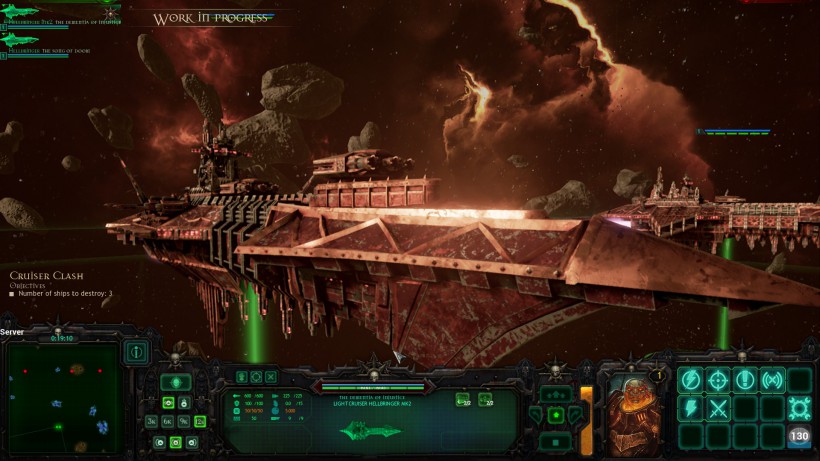Search
[{{{type}}}] {{{reason}}}
{{/data.error.root_cause}}{{{_source.title}}} {{#_source.showPrice}} {{{_source.displayPrice}}} {{/_source.showPrice}}
{{#_source.showLink}} {{/_source.showLink}} {{#_source.showDate}}{{{_source.displayDate}}}
{{/_source.showDate}}{{{_source.description}}}
{{#_source.additionalInfo}}{{#_source.additionalFields}} {{#title}} {{{label}}}: {{{title}}} {{/title}} {{/_source.additionalFields}}
{{/_source.additionalInfo}}Battlefleet Gothic: Armada (PC)

Battlefleet Gothic: Armada
Developed by Tindalos Interactive
Published by Focus Home Interactive
ESRB Rating: Not Rated
Reviewed on Windows PC
Available on: Windows PC
Genre: Real-time Strategy
Number of Players: 1 - 4
Price: $39.99
(Amazon Affiliate Link)
Thanks a million to Tindalos Interactive for sending us a review code!
Battlefleet Gothic is yet another port from a Games Workshop IP tabletop wargame onto PC. The player commands fleets of immense starships in engagements against hostile aliens in the grim darkness of the far future (in other words, the Warhammer 40,000 setting.) The original tabletop game is no longer officially supported by Games Workshop but remains popular with many players.
The campaign is set in the Gothic sector, a region of the Galaxy heavily embattled between the game's four factions; The Imperium, The Eldar, Chaos and Space Orks. The player takes on the role of Captain (later Admiral) Spire as he arrives in the sector and the story unfolds. It is the tale of the 13th Black Crusade, a major event in the history of Warhammer 40,000 in which the forces of Chaos attempted to invade the galaxy and overthrow the Imperium.
This game is very tactical, and players will need to make the most of their ships' abilities and characteristics, leveraging them against opponents' weaknesses. Fleets can be composed of a variety of different classes of ships with their own unique upgrades and loadouts. Some ships will be configured for support roles, some for direct attack. The player does not need to directly control each ship, they can be given their general orders
Despite being set in deep space, the game is still played in two dimensions. To be fair, this is an adaptation of a tabletop game which itself was two dimensional, but it does take away a little of the feel of it being in space, where all three dimensions are in play. No, you won't be simulating any Ender's Game battles in this one, but if you enjoy tabletop games like the original Battlefleet Gothic or Firestorm Armada, this game will feel very natural. The downside is that it feels like a direct port to the computer environment was a missed opportunity to add that third dimension to the game and really make it feel realistic and literally add a new dimension to gameplay. After all, some other starship tactical games like Homeworld were successful at doing so. Would it have been exactly the same as tabletop Battlefleet Gothic? No, but why would it need to?

Strong Points: Excellent graphics, immersive feel, intuitive controls
Weak Points: Intense system requirements, doesn't make use of all 3 dimensions
Moral Warnings: This is a battle game set in a universe with evil gods, xenophobia and genocide
That said, this game is pretty immersive and fun. As is common with Warhammer 40,000 related titles, the story and setting are richly detailed and there's plenty for 40K fans to see and connect with. The four basic factions in the game each have their own character and play style. The Eldar Corsairs are highly mobile with lots of tech gadgets. Orks are aggressive and use ramming tactics, Chaos is unpredictable and heavy on special attacks and the Imperial Navy is the base faction and has flexibility.
While the game has several game modes, they all have many similar traits in common. At the end of each battle, the player earns experience (called renown in the game). As the player advances in level, better equipment, crew and starships become available and can be purchased with renown. When ships are "destroyed" during the battle, they require repair time between battles before they can be deployed again at full effectiveness. This means the ability to retreat from battle by jumping to warp is actually a useful feature, if you know the battle is lost and want to save what you can. The nice thing is that the player gains experience even when losing battles, albeit at a slower rate. This allows the player to build up strength to improve the odds the next time they face a similar challenge. This is a stroke of genius because it means that even a defeat has its rewards and helps prevent feeling discouraged.
Ships are configured with upgrades in a configuration screen that shows a very close up view of the ship and all of the available upgrade options. It's a cool way to get a good look at the amazingly detailed ship models in the game, though it does force the graphics to maximum. I would really have liked it if upgrades to the ship were somehow represented visually on the model itself, though maybe some of the larger upgrades later on in the game will. At least at the beginning, I haven't noticed anything like that. Visual cues like that would be helpful during the battles, because having multiple ships with different loadouts means having to rely on memory and the control panel to keep track of which ships have which upgrades. A way to tell at a glance would have been fantastic, though in fairness most of the time the game will be played with the camera zoomed out too far to notice all but the most obvious details anyway.
Campaign Mode is the main story of the game, and the early stages also serve as the game's tutorial so it's well worth playing, at least in the beginning. Once the actual main story is underway, the game is no longer on rails and allows the player to choose from available missions during each game turn. Sometimes a mission is high priority but generally they can be done in any order the player desires. The campaign is a narrative told by the player as much by the game developers. Failed missions have consequences on the campaign map and the player only gets one shot. For example, in one of the very early missions I had to defend an Imperial supply from Ork pirates. I failed the mission and as a result the destination planet went into revolt because of the people starving from the lack of supply. I had to then go back and secure the trade route as well as quell the uprising.
Solo Skirmish Mode is a simpler battle mode that allows the player to create a fleet and gradually build it up with the ships as well as the Admiral (the player) gaining renown and levels from each engagement which results in upgrades and perks, and carry over into the next
battle. In this way the player can build up a fleet through direct fleet engagements and not bother with the extra details of a story campaign, if preferred. It also offers a chance to practice and learn the different ships as you rise in levels, and you can assemble your fleet before each battle to try different configurations and different ships to build your fleet.

Higher is better
(10/10 is perfect)
Game Score - 88%
Gameplay - 18/20
Graphics - 9/10
Sound - 8/10
Stability - 5/5
Controls - 4/5
Morality Score - 70%
Violence - 5/10
Language - 9/10
Sexual Content - 10/10
Occult/Supernatural - 5/10
Cultural/Moral/Ethical - 6/10
The flexibility makes this almost as much fun as the campaign, which surprised me because I generally prefer the narrative driven stories of campaign mode. In a way, running these battles feels like I'm telling my own story, and in this way the developers have truly captured the feel of Warhammer games, as "forging the narrative" is a big part of the tone Games Workshop tries to set for its fans.
Multiplayer mode is exactly the same as Solo Skirmish mode, including creating a fleet that grows stronger with each engagement. The only difference is that the player is facing a live opponent instead of the computer. Renown, levels and fleet upgrades all work the same way. Up to four players can battle in Multiplayer mode. Of course as with all games that have a multiplayer component, your mileage may vary in terms of the behavior of online opponents. My own experience was good in that regard. I found it enjoyable even though at one point I was given a pasting by an Ork player who really knew how to leverage the aggressive ramming style tactics of the Ork fleet. The game lasted about three minutes and my Imperial fleet was burning in space! Looks like I'll need to spend some time practicing and strengthening my fleet in...
Custom Battles mode! This is a game mode in which the player can set the parameters of the engagement if they want to practice a particular skill or practice against a particular faction. In this mode, the player can choose to use their Solo Skirmish or Multiplayer fleet to work on. It's an excellent way to test configurations the player may be planing to try in a future Multiplayer or Solo Skirmish game as well as earn upgrades for existing fleets used in the other game modes (excluding Campaign).
The controls are fairly typical, with the mouse being the main input. The control panel at the bottom of the screen has the command icons neatly grouped and arranged, and helpful callouts pop up when one mouses over them for a second. For the most part, starships act independently based on general parameters the player can set on the control panel, such as determining at what distance the ship should engage the enemy targets at to maximize the weapons and tactics they will use, or whether to keep enemy targets abeam of the ship to concentrate broadsides, or face them head-on to present a smaller target and engage with lances. (A lance is a massive, powerful energy weapon that is highly effective against void shields.) The player can choose to be more hands-on with individual ships as desired, but it's nice to be able to give general orders to the rest of the fleet and trust them to their own devices, for the most part. Special abilities are still manually deployed, but with the long cooldowns for those abilities it isn't necessary to keep revisiting ships very often.
It's also possible to select enemy vessels to choose specific subsystems to target, such as engines or shields. In this way the player's fleet can focus fire to disable an enemy ship or take out its shields entirely.
The problem I did have was that things happen fast, and sometimes it's hard to react with the mouse in time to avoid specific threats and the buttons on the control panel are fairly small in some cases. The buttons to target specific ship systems on targeted vessels feel barely larger than the point of the cursor, and with the icons on the buttons being so small, I'm glad my eyeglasses are as good as they are. I still have to lean forward and look close to tell whether I'm targeting the engines or the shields.
The graphics are intense, and will test most computers. Even though the machine I played on met the recommended system requirements, I still had to back the graphics quality down from "epic" to "high" in order to make it playable when scrolled in close to the ships. This is mainly because the ships are amazingly detailed even when fully zoomed in. The Imperial starships of the 40K universe are styled to look like a cross between an ancient Roman warship and a cathedral, and all of that style is translated successfully into this computer game.

The sound effects are adequate, if not spectacular. The voices of other characters come through clear and are easily understood. Audio clipping can be a real problem if the system is slowed down, as it would be when the graphics are too high, for instance. The music is typical fare for a 40K game, being slow, brooding, bombastic classical music. It sets the tone very well.
When initially playing the game I had issues with a very slow framerate and audio clipping when zoomed in for a close look at my ships. Zooming out helped but ultimately I had to lower the graphics settings slightly to get the game running smoothly. The ship configuration screen still has a low framerate because it appears the graphics are always turned up to maximum there.
As for morality... If you've played any Warhammer 40,000 properties at all this game gives you exactly what you'd expect. Immense starships blasting away at each other in deep space means people die in horrific numbers, though this is not depicted onscreen. Death is therefore abstracted enough that the player's awareness of what's really happening has more to do with individual imagination than graphics.
What is more personal is the main character, who is tested early in the campaign to measure his faith during one of the early cutscenes in the campaign. The process involves psykers (telepaths) who are not gentle when probing him. We do not directly see what happens, but the door to the testing cell closes and the screaming begins behind it. This scene is very reminiscent of the sequence in The Empire Strikes Back where Han Solo is being tortured, screaming behind a door as Darth Vader and Lando Calrissian converse outside.
I didn't catch any strong language, and as is normal for 40K games, there's no sexual content of any kind.
There is also the matter of the setting, in which the Emperor is commonly revered as a god. The main character in the campaign mode refers to him as the "God Emperor" and prays to him often even as his faith is tested.
One of the playable factions is Chaos, which itself represents a pantheon of four superpowerful Warp entities, collectively known as the "Chaos Gods." They are, of course, one of the evil factions. The player can also choose from two alien factions, Orks and Eldar. None of the game's factions truly represents "good" the way we would think of it, though there are varying degrees.
Ultimately, this game delivers pretty much what one would expect from a Warhammer 40,000 property and veterans of tabletop Battlefleet Gothic will find this game very familiar. There's plenty to do with all the game modes and available factions so replay value is good. For people who are interested in the tactics and complexities of a three dimensional space combat game this one won't satisfy, but for 40K enthusiasts this title is a must have.








